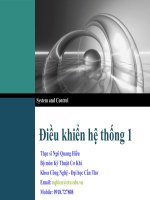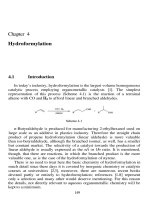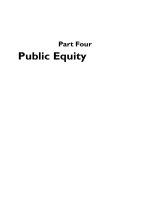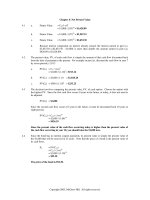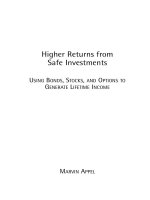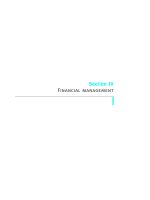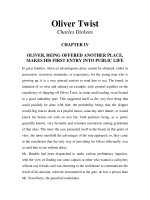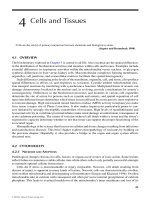Chapter 4.Pdf
Bạn đang xem bản rút gọn của tài liệu. Xem và tải ngay bản đầy đủ của tài liệu tại đây (44.04 KB, 6 trang )
All of the following are components of a
bank's non-interest expense except:.
a. deposit service fees.
b. occupancy expense.
c. goodwill impairment.
d. personnel expense.
e. other intangible amortization.
a. deposit service fees.
Banks can increase their operating efficiencies by:
a. reducing costs and maintaining the existing level of
products and services.
b. reducing costs and reducing the existing level of
products and services.
c. decreasing the level of output while maintaining the
current level of expenses.
d. increasing the level of output while increasing the
level of expenses.
e. decreasing workflow.
a. reducing costs and maintaining
the existing level of products and
services.
Banks experience diseconomies of scale when:
a. marginal costs increase as total costs decrease.
b. total costs decrease as output decreases.
c. total costs increase as output increases.
d. average unit costs increase as output increases.
e. average unit costs decrease as output increases.
d. average unit costs increase as
output increases.
Banks experience economies of scale when:
a. marginal costs increase as total costs decrease.
b. total costs decrease as output decreases.
c. total costs increase as output increases.
d. average unit costs increase as output increases.
e. average unit costs decrease as output increases.
e. average unit costs decrease as
output increases.
Customer profitability data can be
beneficial in helping bank management:
a. develop new products.
b. identify profitable target niches.
c. determine changes in product pricing.
d. All of the above
e. a. and b. only
d. All of the above
For most banks, which of the following is the
largest component of non-interest expense?
a. Personnel expenses
b. Rent
c. Required reserves held at the Federal Reserve
d. Electricity
e. Depreciation on buildings and equipment
a. Personnel expenses
From the following list, which two are the biggest contributors to non-interest income?
Fiduciary Activities
Deposit Service Charges
Trading Revenue
Investment Banking
Insurance Commission Fees and Income
Other Non-Interest Income
a. Fiduciary Activities & Deposit Service Charges
b. Trading Revenue & Investment Banking
c. Insurance Commission Fees and Income & Other Non-Interest Income
d. Depository Service Charges and Other Non-Interest Income
e. Fiduciary Activities and Investment Banking
If a bank pays 62 cents in non-interest
expense per dollar of income, its _______ is
equal to 0.62.
a. burden
b. net non-interest margin
c. efficiency ratio
d. overhead ratio
e. noninterest expense ratio
d. Depository Service Charges and
Other Non-Interest Income
c. efficiency ratio
In general, _______________ are the major noncredit cost for commercial customers.
a. personnel expenses
b. check-processing costs
c. loan administration expenses
d. fraud costs
e. default costs
b. check-processing costs
______________ is/are the primary revenue source
for a majority of banks.
a. Check-processing fees
b. Investment income from deposit balances
c. Loan interest
d. Earnings credits
e. Swaps
c. Loan interest
__________ is not a measure of bank
productivity?
a. Assets per employee
b. Average personnel expense
c. Loans per employee
d. Net income per employee
e. Number of customers per employee
e. Number of customers per
employee
The operating risk ratio measures:
a. cost controls versus fee generation.
b. fee income versus net interest margin.
c. noninterest expense versus noninterest income.
d. depositors versus employees.
e. depreciation versus required reserves.
a. cost controls versus fee
generation.
Profitable bank customers:
a. make up a small fraction of all bank
customers.
b. generally shop for the bank with the
lowest price.
c. have small loan balances.
d. always avoid service charges.
e. are the most sensitive to changes in price.
a. make up a small fraction of all
bank customers.
Return on risk-adjusted capital is defined as:
a. Income/Allocated Risk Capital.
b. Allocated Risk Capital/Adjusted Income.
c. (Risk - Adjusted Income)/Capital.
d. Capital/Allocated Risk Capital.
e. Expenses + Target Profit.
a. Income/Allocated Risk Capital.
T or F
Banks with the highest efficiency
ratios are presumed to be the most
efficient.
False
T or F
Community banks relied more on
investment banking, relative to
larger banks, to increase noninterest income.
False
T or F
Demand for checking accounts is
generally considered to be price
inelastic.
True
T or F
Deposit service charges are a stable
source of bank revenue.
True
T or F
Increased competition, following
deregulation, has led to an increase
in bank's net interest margin.
False
T or F
Larger banks have lower efficiency
ratios, on average, than smaller
banks.
True
T or F
Mortgage origination is
countercyclical to a bank's net
interest margin business.
True
T or F
Offering remote deposit capture is
high cost but low risk for a bank.
False
T or F
Relative to larger banks, smaller
banks rely more on non-interest
income as a source of revenue.
False
T or F
Trading revenue for banks is highly
cyclical.
______________ transactions are the highestcost type of transaction for a bank.
a. Web-based
b. ATM
c. Work station
d. Live teller
e. After-hours
True
d. Live teller
When two banks that merge have a significant
duplication of bank offices such that the merger
leads to the elimination of branches and personnel,
this is known as a(n):
a. out-of-market merger.
b. in-market merger.
c. new-market merger.
d. reduced-branch merger.
e. goodwill merger.
b. in-market merger.
Which of the following is considered a measure
of bank productivity?
a. Return on assets
b. Return on equity
c. Assets per depositor
d. Assets per employee
e. All of the above are measures of bank
productivity
d. Assets per employee
Which of the following is not a cost management
strategy?
a. Investing in resources to improve long-term
profitability
b. Changing pricing such that total revenues
increase
c. Identify operating efficiencies
d. Burden identification
e. Expense reduction
d. Burden identification
Which of the following is not considered a
non-interest expense?
a. Wages and salaries
b. Rent
c. Required reserves held at the Federal
Reserve
d. Electricity
e. Employee benefits
c. Required reserves held at the
Federal Reserve
Which of the following is not listed on a
bank's UBPR as noninterest income?
a. Deposit service charges
b. Insurance commission fees
c. Goodwill impairment
d. Net gains on sales of loans.
e. Investment banking fees
a. Deposit service charges
